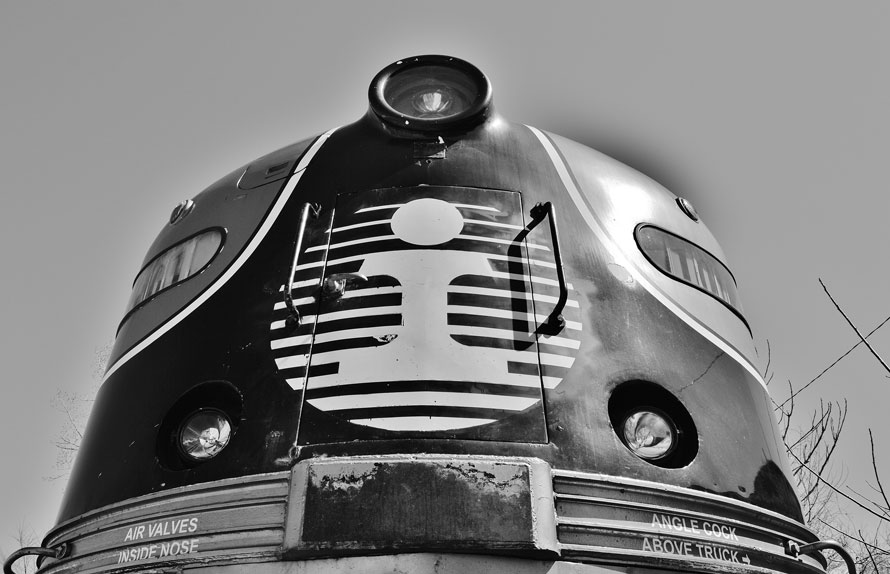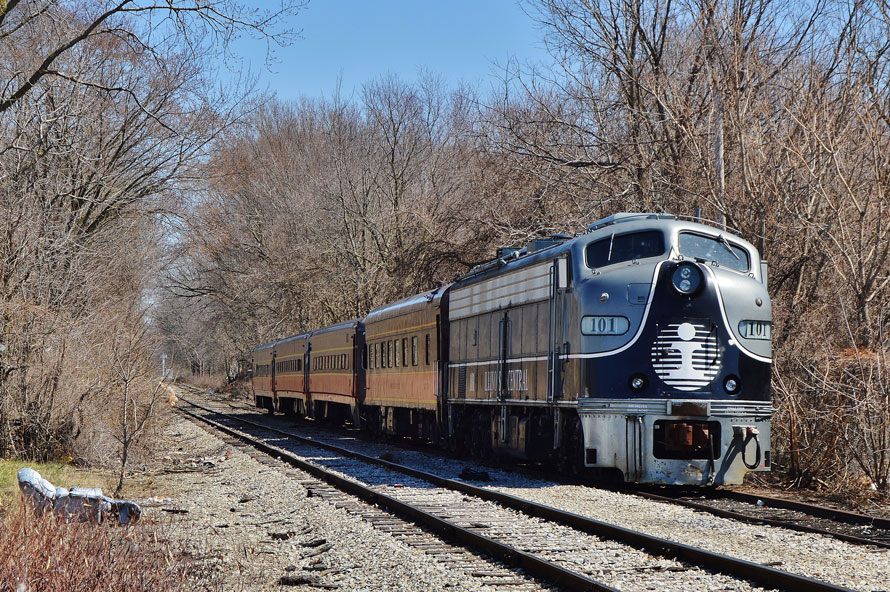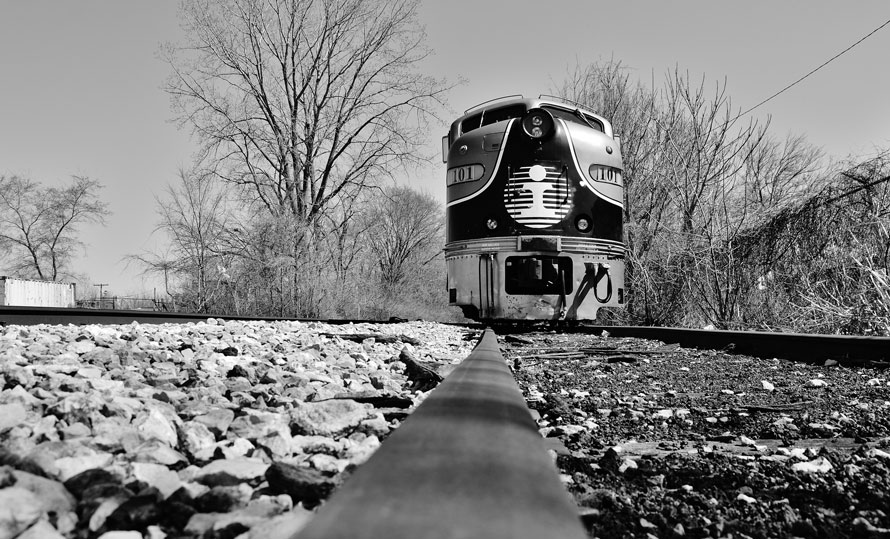
Most railfans, at some point or another, are asked what their first train sighting was. For me, I can’t remember the first time I saw a train, but I do remember the first time I took a picture of a train. May 16, 2010 was the date. The event was the annual Railroad Days festival held in Homewood, Illinois.
Railroad Days, located in downtown Homewood near the entrance to Canadian National’s (CN) bustling Markham Yard, has been held every year since 2004 (except 2020 due to the pandemic). It’s the town’s way of celebrating their 150+ years of being a major railroad hub. Model train displays, vendors, rides on the CN’s little “train on tires” that drives around a parking lot adjacent to the yard, and lots of railfanning make up the special day.
For seven-year-old me, this was something exciting beyond belief, and in all likelihood, I did not get any sleep the previous night as I eagerly awaited for my dad to get up and take me to Homewood. When we finally got there, we first checked out the model train displays. I talked my dad into getting me an HO scale locomotive for my rapidly expanding model collection, and then we headed over to the then new Homewood Railfanning Platform, located near the Amtrak station, to watch some trains before heading home.
The timing couldn’t have been better. As we were walking to the platform, I heard my dad say, “Holy crap, what is that?” I turned my head to see a freshly painted CN locomotive approaching. What got my dad’s attention is what it was pulling: a shiny black, white, and gray Illinois Central (IC) business car that had not yet been repainted into CN colors, followed by a matching E9 diesel. The head end of the special train stopped right in front of us. A lucky railfan climbed down from the cab and excitedly yelled, “Wahoo! That was fun!”
Even though we didn’t get a cab ride, we were just as excited. My family has always been an “IC family,” having lived in Monee, Illinois for nearly fifteen years right along the Chicago to New Orleans mainline. Hearing Steve Goodman’s City of New Orleans being played in our house was common. So, when we saw that E9 being dragged into Homewood for display during the event, we rushed over to check it out.
I quickly identified the locomotive as Illinois Central’s No. 101, originally Chicago Burlington & Quincy No. 9977. It holds the distinction of being the CB&Q’s last E unit ever acquired. Built by EMD’s La Grange shops in September, 1953 as an E8, the 9977 was rebuilt by the Burlington Northern circa 1975 into an E9 and numbered 9904. The unit finished out its career on Burlington rails powering commuter trains between Chicago and Aurora, Illinois, until it was retired in July of 1992.

Shortly after retirement, the 9904 was purchased along with sister 9901 (formerly CB&Q 9938) by the Illinois Central for use on their new business train, made up of historic passenger cars painted in their iconic black, white, and gray “Death Star” scheme. The two units were painted into matching colors, received the numbers 100 (9901) and 101 (9904), and served as the railroad’s business train power and public relations ambassadors for two decades before being retired by Canadian National, who acquired the IC in 1998, in late 2012. While they weren’t true Illinois Central locomotives, for this seven-year-old IC fan, they were just as special.
Both of us had no idea at the time that the photograph I had just taken had marked the beginning of a lifelong passion for railroad photography”
For reasons unknown, the 100 was not present at the 2010 Homewood Railroad Days, but my dad and I were not complaining. For what seemed like forever, we marveled over the 101’s beauty as it basked in the morning light. In 1964, Trains editor David P. Morgan wrote a wonderful E unit tribute article titled “Those Esthetic E’s,” and esthetic they are. The skilled designers at EMD most definitely took the looks of these locomotives into consideration while designing them. Perhaps they did not know that some 57 years later they still impressed anyone who had the privilege of viewing them. I was no exception—I had never seen an EMD “covered wagon” before, and that first encounter left a lasting impression on me. Ever since I first saw the 101, E and F units have been my favorite diesel locomotives.
Then, history happened. My dad reached into his pocket and pulled out his old first generation digital Canon camera. At the time, neither he nor I were railroad photographers, but what happened next changed that. “Tom, do you want to take a picture of it?” I excitedly said yes, and I snapped my first train picture ever—what I suppose would classify as a “roster shot” of the 101. Both of us had no idea at the time that the photograph I had just taken had marked the beginning of a lifelong passion for railroad photography for both of us. Since then, we have traveled thousands of miles all over Illinois and surrounding states to document railroads, and it all started with that simple click of a camera in front of the 101.

All too soon, we got in the car and headed home. The 101 pulled the business car and CN locomotive back into the yard, and by nightfall, no evidence of a special event in Homewood was present. Right away, I wanted to go see the 101 again, but subsequent trips to Homewood and the engine house at Markham Yard where it was stored proved to be unsuccessful in finding it. I do recall one occasion where we saw the business cars parked deep in the yard, but neither the 100 or 101 were anywhere in sight. I never got to see the 100.
The two units remained active on the Canadian National’s roster for a couple more years and continued to see limited use at special events, including the CN’s Christmas trains in Illinois, Indiana, and Michigan. They also made an appearance at the 2012 National Train Day celebration at Union Station in Chicago. After the NTD event, the two units were unceremoniously withdrawn from service and placed in long-term storage at Markham. CN, modernizing their fleet, no longer had a use for their predecessor’s special diesels. Two of their own E units, painted in classic CN streamliner colors, were being used instead.
After that, the 100 and 101 sat side-by-side buried deep in the Markham engine house, patiently waiting to be called back out to the high iron. Occasionally, a CN worker would sneak a camera into the building and snap a quick photo of them to share online, revealing the engines still in good shape, but collecting so much dust that their gray noses were turning light brown.
In the time that they were in storage, my railfanning hobby had greatly expanded. I had made several new railfan friends, and quickly learned that all of us had a soft spot for the two E units. We kept close tabs on them, and every time a new photo of them in the engine house would pop up, I was usually the first to inquire about their status and if they were going to be returned to service or not.
However, as time went on, the lack of the E units’ presence caused my interest in them to slowly diminish. New trains were capturing my attention. We moved away from the IC mainline to Indiana in 2014, and our visits to Homewood became rarer and rarer. Even so, I still had that first photo I took of the 101, and while I was no longer keeping close tabs on it, it still held a special place in my heart.
At our new home in Indiana, we were surprised to discover that one of our neighbors was a conductor for CN based out of Markham Yard. One day, I asked him if he knew anything about the status of the E units. Unfamiliar with older locomotive models, it took some explaining before he said, “Oh yeah, the one that looks like a bullet.” He explained that he was not at liberty to discuss what was going on, but he did say that they were the subject of some conversations amongst the local CN management.
A few months later, the public got word of what those conversations were about. Canadian National announced that the 100 and 101 were going to be auctioned off. While this wasn’t the outcome many of us wanted to hear, my friends and I remained optimistic and eagerly waited to hear what was in store for them. Soon after the announcement was made, a new photo of the units surfaced on the Internet. A few days later, Ed Ellis, owner of Iowa Pacific Holdings, commented, “Iowa Pacific’s bid is in.” Ed won the auction for both units. Iowa Pacific Holdings owned several short line railroads around the country and Ed had collected many pieces of historic railroad equipment to operate on them. At long last, it appeared that the 100 and, more importantly to me, the 101, had a bright future ahead of them . . . or so I thought.
The two locomotives were soon dusted off, patched for SLRG (Iowa Pacific’s reporting marks), and shipped to Bensenville, Illinois. Much like my dad and I, Ed Ellis was a big IC fan, and was able to acquire the rights to the classic brown and orange paint scheme that once adorned the IC’s streamliners of the 1950s and 60s. His plan was to paint both the 100 and 101 into that scheme. The 100 was painted first, but before the 101 could also be painted, it was needed in service at one of the Iowa Pacific’s properties, so it was quickly moved out of storage in Bensenville and placed into service.
The repainted 100 went to the San Luis & Rio Grande Railroad in Colorado where it remains today. The 101 hopped around various Iowa Pacific properties throughout the late 2010s, still in the IC’s Death Star paint, before winding up at Kokomo, Indiana along with a string of Iowa Pacific-owned and leased passenger cars to assist the troubled Indiana Transportation Museum by serving as their Polar Express consist during the Christmas season. Despite living relatively close to Kokomo, I regretfully never made it out to see it operate there.
By this time, Iowa Pacific was in increasing financial trouble for various reasons, and railfans began to wonder if they would end up selling their equipment, including the 101. The “train set” in Kokomo ran for the last time during the Christmas season of 2019, before it was parked on a spur track along the Toledo, Peoria & Western on the city’s east side to await future operations with the Indiana Transportation Museum.
The COVID-19 pandemic put an end to all plans of running it in 2020, and in early March of 2021, it was announced that the entire Iowa Pacific collection of locomotives and rolling stock were to be sold at a bankruptcy auction. I was devastated to learn of this, as I had not yet seen the 101 under Iowa Pacific ownership. and was hoping to go see it in action in Kokomo after the pandemic had ended.
To make matters worse, due to various circumstances regarding the condition of the equipment in Kokomo, the rather high starting bid prices in the auction, and other reasons, multiple reliable sources said that scrapping is a definite possibility. At the time of this writing in June of 2021, nothing about the equipment’s fate has been confirmed yet, but I was not going to take any chances. I wanted to see the 101 again, even if it was for the last time.
On the first day of my school’s 2021 spring break, my dad and I drove down to Kokomo to be reunited with our old friend. It was hard to believe that almost 11 years had gone by since we saw it for the first and last time.
When we arrived in Kokomo, we soon realized that the 101 was stored in the not-so-nice area of town. We pulled into a gravel parking lot near the tracks and noticed a large barbed wire fence adjacent to the lot with an intimidating “KEEP OUT” painted in bright red letters on a gate. My dad turned to me and said, “Make it quick, Tom, I don’t want us to get shot.”
I grabbed my camera and started walking towards some trees along the tracks. On the other side of those trees was the 101, the engine that started it all. I wondered what it would look like after all these years. I wondered what its future had in store. I wonder if there was a future for it at all. I reached the tree line and started climbing through the brush.

There it was—”the one that looks like a bullet”—in all of its glory. From a distance, the engine looked mostly the same as it did when I first laid eyes on it in Homewood. ITM volunteers had removed the SLRG patches and it was once again Illinois Central 101. I snapped a couple quick pictures, then started back through the brush to return to my dad, who was probably about to start honking for me to come back so we could get out of that sketchy parking lot. I stopped, turned back to look at it one more time, and realized that this may be the last time I would ever see it.
Normally, I never even think about going onto railroad property. Depending on the situation, I occasionally even call in trespassers I see to the railroad police. Today, however, was an exception. The tracks were lightly used, there were no “No Trespassing” signs anywhere, and there was no fence keeping me out. I had seen photos of the 101 here online taken from right next to it, and railroad employees had even liked and commented on them. It was clear that nobody cared if I went up to it, so I quickly and carefully crossed the active track and started walking up the disused spur to the engine.
In the eleven years since I had last seen the 101, it had been through a lot, and likely received little, if any maintenance. The recent time being stored outdoors in Kokomo was especially not kind to the ailing locomotive. Up close, signs of the 101’s deterioration became evident. There was multiple patches of rust in various places, fading paint, and, most notably, the windshield on the fireman’s side of the cab had a giant crack in it, likely caused by a vandal throwing something at it. Come to think of it, in a rough neighborhood like that, I’m surprised that the damage wasn’t worse.
Even so, it hurt to see the 101 with any damage at all. I took some more photos, gave the front coupler a quick pat, then went back to the car. On the way home, I began daydreaming about what it would be like if I could’ve taken it home with me. Owning the locomotive of my childhood would be downright amazing. I’m sure other people have thought about it too. Alas, time, space, and money would not allow for such things to happen, so I started to brainstorm ideas on how I could preserve at least the memory of the 101. I decided that the best way to do so was by writing this article.

As sad as it is, it’s very likely that this recent, second encounter of mine with the 101 will be the last. In the event that it’s sold, it will probably be taken to a faraway place and stripped of its Illinois Central identity. Or, in the worst case scenario, it will become a victim of the cutting torch, and chopped up into unrecognizable pieces of twisted steel at that sketchy parking lot in Kokomo.
Whatever the outcome is, myself, along with probably many others, are anxiously awaiting to find out what’s next for the “one that looks like a bullet.”
Thomas Dyrek – Photographs and text Copyright 2021 (Except as noted)
Tom,
I enjoyed your article immensely and all throughout had hoped you could have saved her. Although we missed the 101 by two years, my wife, two youngsters, and I used to spend enjoyable afternoons during the 80’s and 90’s at the Naperville, Ill. station watching the Burlington Northern’s dinkie parade traverse the racetrack. Thanks for a most enjoyable trip down memory lane.
Tom Surface
Chesterfield, Va.